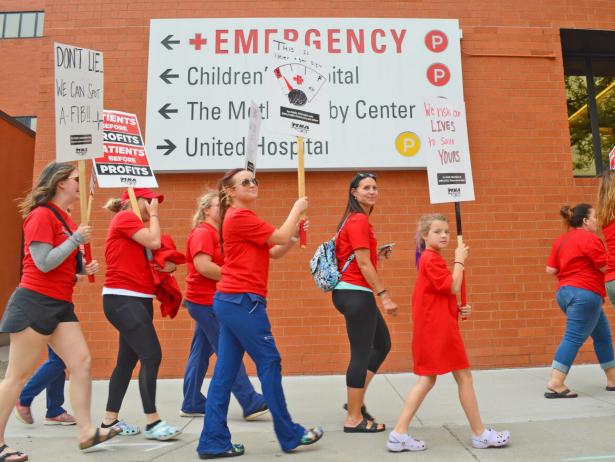Registered nurses picketed outside 11 Twin Cities hospitals Wednesday, calling on health care executives to put patients over profits in contract negotiations with their union, the Minnesota Nurses Association (MNA).
Talks covering 15,000 nurses in the metro and Duluth began in March. Twin Cities nurses, who work at Allina Health, Children’s Hospital, M Health Fairview and North Memorial hospitals, saw their contracts expire Tuesday.
On a combined picket line outside United and Children’s hospitals in St. Paul, nurses said the crisis facing their profession demands urgency and bold action to keep nurses from leaving the bedside.
“I think a lot of our co-workers are waiting to see what happens with this contract to make determinations about what they’re going to do next, if they’re going to stay at the bedside,” United emergency department nurse Brittany Livaccari said. “We can’t continue to try to take care of patients and not be able to provide the care that we know they deserve. We’re ready to fight for our patients.”
But at the bargaining table, hospital administrators have failed to meet that urgency.
Instead, hospitals want concessions from the union to gain more scheduling flexibility, and they have balked at nurses’ demands for more say over staffing levels, increased pay, family and medical leave, and other measures to recruit and retain nurses.
Lisa Sanford, an intensive care nurse at Children’s in St. Paul and member of the bargaining committee, said management is back to treating nurses like numbers on a spreadsheet after showering essential workers with platitudes during the height of the COVID-19 pandemic.
“For two years now we’ve been asked to put ourselves last, but now it’s become an expectation,” Sanford said. “It’s unsustainable, and it’s precisely why we have lost so many at the bedside.”

Sanford said “block scheduling” language in nurses’ previous union contract is “non-negotiable” for members of her bargaining unit, who rely on the stability it provides to care for themselves and their family members. More, she called management’s proposals to “float” more nurses between units a dangerous and unsustainable fix for staffing shortages.
“A nurse is not a nurse is not a nurse,” Sanford said. “It doesn’t do me any good to have a nurse who’s not an ICU nurse in my ICU. Nurses have set skills, and when you take them out of their environment, you put everybody at risk.”
Last month, the MNA released a report showing the number of reported staffing concerns from its members doubled from 2020 to 2021, pinning blame on hospitals for inadequately staffing units and failing to address high rates of turnover. Sanford said about 40% of nurses at her hospital have left the bedside.
But staffing issues didn’t start with the pandemic. Livaccari said Allina Health, which owns United Hospital, began “benchmarking” its nurse staffing in 2019, looking to align staffing levels with comparable hospitals in other parts of the country.
“They wanted us in the bottom 40th, meaning 60% of the hospitals that are benchmarked to (United) would have better staffing than we would,” she said. “In terms of patient care, that means we have delays, we have less time to spend individually with patients.
“Your emergency is an emergency, whether you’re about to stop breathing or your heart’s about to stop, or if you broke your arm. We don’t want you to have to wait. You shouldn’t have to wait eight hours for care. You shouldn’t even have to wait two hours, but that’s a typical thing we’re seeing.”

Livaccari and other nurses often point to short staffing’s “snowball effect,” as frustrations boil over into more nurses leaving the bedside, adding to the crisis. Many nurses that remain extend their work agreements to cover the gap, often at a cost to their own health.
“When you hear your co-workers are drowning and the patients are at risk, you want to go in,” said Sanford, who has increased her work hours by about 35%. “But it has absolutely taken a toll.”
Meanwhile, many hospitals have increased executive pay, and they continue to address high turnover rates by filling vacancies with temporary, traveling nurses, whose wages are significantly higher.
“Our CEO got a 47% increase in his pay from 2018 to 2019,” Sanford said. “I think they can handle giving us a little bit more.”
In addition to informational picketing Wednesday MNA also launched a new advertising campaign this week, highlighting hospital CEO pay and urging supporters to visit MNPatientsBeforeProfits.com to share their stories about the impact of short-staffing in hospitals.
“Hospital executives with million-dollar salaries have created a staffing and retention crisis which is pushing nurses away from the bedside,” MNA President Mary C. Turner said. “The future of our healthcare system depends on the choices we make now. Nurses are ready to fight and win for our patients and our practice. I hope the public will stand with us in our fight to put patients before profits in our hospitals.”
Workday Minnesota holds the powerful to account while bringing the perspective of everyday workers and the organizations that defend their rights to focus. Workday emphasizes long-form investigative journalism to bring to light the concealed and buried.
Workday Minnesota fulfills the mission of the Labor Education Service at the University of Minnesota by providing a public outlet to examine the conditions that workers face on a day to day basis. Workday began publishing in the summer of 2000 with support from Minnesota’s labor community. It was the first on-line labor news publication in the United States.


Spread the word